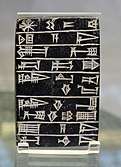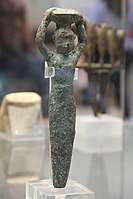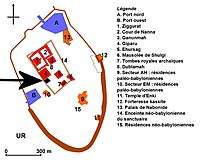Nimintabba
Nimintabba (𒀭𒐏𒋰𒁀 DNimin-tab-ba, previously read Dimtabba) was a Goddess of Sumer.[4]
NIN-a-ni..................... "his Lady,"
SHUL-GI.................... "Shulgi"
NITAH KALAG ga...... "the mighty man"
LUGAL URIM KI ma... "King of Ur"
LUGAL ki en............... "King of Sumer"
gi ki URI ke................. "and Akkad,"
E a ni.......................... "her Temple"
mu na DU................... "he built"[1]
A Temple was built for her at Ur by the Sumerian king Shulgi, circa 2100 BCE.[4] The remains of the Temple were excavated in Ur by Wolley.[5] Various artifacts with the name Nimintabba were found in the vicinity of the Temple.[4] She seems to have been a rather minor, local deity.[6][4]
Nimintabba is also known from a famous dedicatory inscription by Shulgi, found in the foundation of the Nimintabba Temple of Ur, and now in the British Museum (ME 118560).[7][8]
A foundation figurine was also found under the northeastern wall of Temple of the Goddess Nimintabba, encased within baked brick boxes, and accompanied by steatite tablets, with the figurine positioned standing and leaning north east. The steatite tablets rested on the bottom of the sealed box.[9] The male figurine represents the king Shulgi, a connection provided by the historical implication of the figure's posture. The posture of the figurine replicates the posture associated with royal iconography established in the mid-third millennium BCE.[9] The basket atop the head of the figurine also resembles images of Assurbanipal (686-627 BCE) with a basket on top of his head. Inscriptions connect this image with the construction of the temple.[9] These pieces of evidence combined with the inscription on the lower half of the figures contribute to the probability that the figurine under the Temple of the Goddess Nimintabba was a dedication to Nimintabba by Shulgi, claiming responsibility for the construction of the temple.[9]
References
- "(For the goddess) Nimintabba, his lady, Shulgi, mighty man, king of Ur, king of Sumer and Akkad, her house, built." in Expedition. University Museum of the University of Pennsylvania. 1986. p. 30.
- "Nimintabba tablet". British Museum.
- Enderwitz, Susanne; Sauer, Rebecca (2015). Communication and Materiality: Written and Unwritten Communication in Pre-Modern Societies. Walter de Gruyter GmbH & Co KG. p. 28. ISBN 978-3-11-041300-7.
- "Another little-known deity is Nimintabba. This goddess had a small temple in the city of Ur, built on the orders of king Shulgi..." in Toorn, K. Van Der (1996). Family Religion in Babylonia, Ugarit and Israel: Continuity and Changes in the Forms of Religious Life. BRILL. p. 83. ISBN 978-90-04-10410-5.
- "UrOnline - The Digital Resource for the Excavation of Ur". www.ur-online.org. British Museum and Penn Museum.
- "The goddess Nimintabba, in whose temple at Ur the artifacts featured in this article were found, is not among the major deities of the Mesopotamian pantheon, and her name occurs infrequently in written sources." Expedition. University Museum of the University of Pennsylvania. 1986. p. 30.
- "Nimintabba tablet". British Museum.
- Enderwitz, Susanne; Sauer, Rebecca (2015). Communication and Materiality: Written and Unwritten Communication in Pre-Modern Societies. Walter de Gruyter GmbH & Co KG. p. 28. ISBN 978-3-11-041300-7.
- Zettler, Richard L. (January 1, 1986). "From Beneath the Temple: Inscribed Objects from Ur". Expedition 28: 29–38, 32, 33, 36.
- "Shulgi figure from Temple of Dimtabba". British Museum.
- "UrOnline - The Digital Resource for the Excavation of Ur". www.ur-online.org. British Museum and Penn Museum.

.jpg)



_-_EnKi_(Sumerian).jpg)